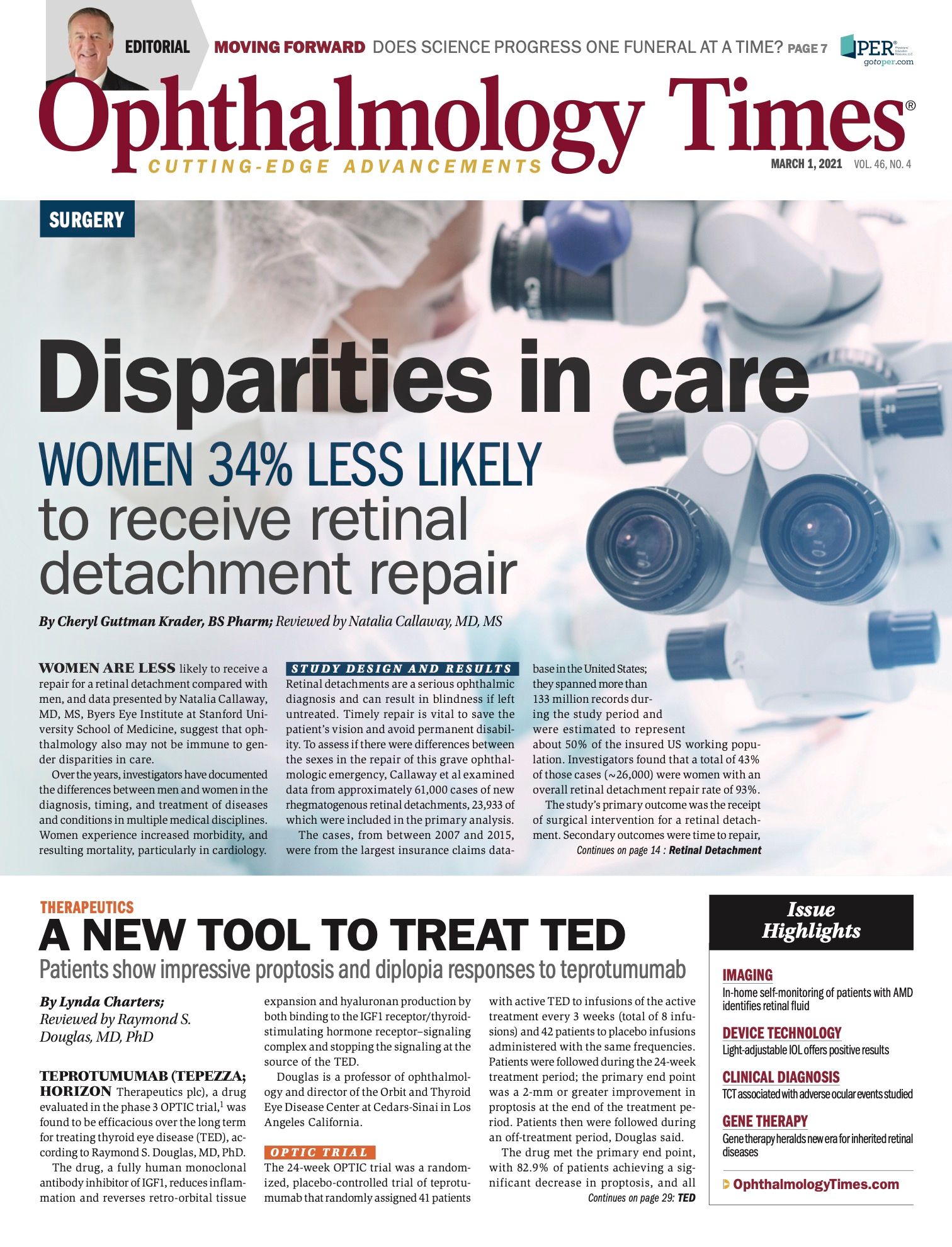Publication
Article
Digital Edition
Investigators uncover health care disparities among US patients
Author(s):
Study highlights role of demographic and socioeconomic characteristics in treatment.


This article was reviewed by Rishi P. Singh, MD
A retrospective cohort study characterizing presenting disease-related features, treatment, and outcomes of patients with diabetic macular edema (DME) reinforces the existence of racial/ethnic and socioeconomic health care disparities in the US population.
The research, presented recently by Rishi P. Singh, MD, was conducted to understand how presenting visual acuity and diabetic retinopathy severity differ among patients receiving anti-VEGF injections for DME and to characterize associations between socioeconomic factors and anti-VEGF injection utilization and visual acuity outcomes.
Related: Research suggests course of diabetic eye disease influenced by genetic factors
The analyses showed that Hispanic/Latino ethnicity and Medicaid insurance were associated with worse presenting visual acuity at diagnosis.
Factors associated with receipt of a higher number of anti-VEGF injections over time were non-Hispanic ethnicity, private insurance status, and White race. Non-Hispanic ethnicity and private insurance status also correlated with better long-term visual acuity outcomes.
“Our study’s results are consistent with those of some previous studies, including an analysis of patients at Cole Eye Institute,” said Singh, a retina specialist at Cleveland Clinic Cole Eye Institute and an associate professor of ophthalmology at Cleveland Clinic Lerner College of Medicine of Case Western Reserve University in Ohio. “While we think the natural history of DME is influenced by glycemic control, the time since diabetes diagnosis, and ophthalmic interventions, we are realizing from the accumulating research that it is far more complex. Rather, patient outcomes depend on multiple interrelated factors, including health care access, disease burden, and racial and social factors.”
Identification of the disparities provides a foundation for further research and efforts to rectify the issues.
Related: Disparities in care of retinal detachments
“We are hoping to improve physician understanding of the social determinants of health and barriers to care to develop appropriate treatment plans for at-risk populations,” Singh said. “In addition, we would like to expand our research to examine other factors as possible predictors of anti–VEGF injection utilization, including education, [hemoglobin] A1c level, smoking status, distance to clinic, and racial-ethnic biases in health care settings.”
Singh said investigators also recognize the need to characterize literacy among patient populations and with regard to ophthalmic interventions as a means to identify opportunities for improving access to regular anti-VEGF injections for at-risk populations.
Investigators for this retrospective cohort study searched the IRIS Registry to identify adults (aged > 18 years) with a diagnosis of treatment-naive DME receiving their first anti-VEGF injection.
Related: Post hoc analysis: Protocol V provides more practical DME guidance for clinicians
A total of 203,673 patients met the eligibility criteria, with most (51%) residing in the southern United States. The patients had an average age of 60 years and were nearly equally represented by men and women.
Approximately 50% of the population had diabetic retinopathy, and the largest proportion of patients with diabetic retinopathy had proliferative disease. Baseline visual acuity for the entire population was an Early Treatment Diabetic Retinopathy Study (or ETDRS) letter score of approximately 66.
Related: Identifying gaps in anti-VEGF treatment among minorities with DME
Study results showed a stronger correlation between diabetic retinopathy severity and Black/African American patients vs White patients, Hispanic/Latino patients vs non-Hispanic/non-Latino patients, and patients with Medicaid vs those with private insurance.
Factors associated with better visual acuity at presentation included younger age and male gender.
Again, there were statistically significant differences favoring White patients vs Black/African-American patients, non-Hispanic/non-Latino patients vs Hispanic/Latino patients, patients with private insurance vs those with Medicaid, and patients with Medicare coverage versus those with Medicaid.
Analyses comparing patients with mild nonproliferative diabetic retinopathy to those with either severe nonproliferative disease or proliferative disease showed that patients having a worse level of diabetic retinopathy also had worse visual acuity at presentation.
Related: VIDEO: Updates in DME, diabetic retinopathy
Visual acuity at presentation among non-Hispanic patients was similar across all geographic regions, defined as Midwest, Northeast, South, and West.
However, geographic disparity in visual acuity at presentation was noted among Hispanic patients and patients with Medicaid as their primary insurance.
“In particular, our study showed that visual acuity at presentation was lower among Hispanics and those living in the Sunbelt states, where diabetes prevalence is very high,” Singh said.
Analyses of anti–VEGF injection utilization showed that patients received about 3.8 injections during the first year after diagnosis.
Differences in anti–VEGF injection utilization showed higher utilization among White non-Hispanic patients versus White Hispanic patients, Medicare and private insurance patients versus Medicaid patients, and patients with less severe versus more severe retinopathy.
The study also evaluated factors associated with differences in visual acuity during 5 years of follow-up. These analyses showed that compared with White patients, Black patients had worse visual acuity at baseline and throughout the duration of follow-up.
Related: Identifying biomarkers to predict diabetic retinopathy progression
Disparity also existed between Hispanic and non-Hispanic patients, with Hispanic patients presenting with and maintaining worse visual acuity throughout the study, and the difference between Hispanic and non-Hispanic patients was even greater than the disparity between Black patients and White patients.
Patients with more severe diabetic retinopathy at baseline also maintained worse vision throughout follow-up compared with those less severely affected.
An analysis with patients stratified by insurance status showed all groups maintained the same mean visual acuity throughout follow-up.
The best average visual acuity was found among private insurance patients, followed by those with Medicare coverage; those with Medicaid had the worst visual acuity.
Interestingly, however, when patients were stratified by race/ethnicity and insurance status, Hispanic patients with private insurance had worse visual acuity at presentation and at 5 years than non-Hispanic Medicaid patients, Singh concluded.
--
Rishi P. Singh, MD
e:drrishisingh@gmail.com
This article is based on Singh’s presentation at the American Academy of Ophthalmology 2020 virtual annual meeting. Singh is a consultant to companies that market treatments for DME and diabetic retinopathy.

Newsletter
Don’t miss out—get Ophthalmology Times updates on the latest clinical advancements and expert interviews, straight to your inbox.





.png&w=3840&q=75)































